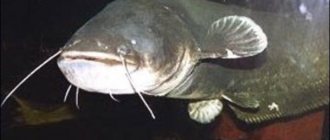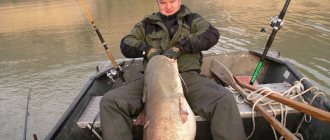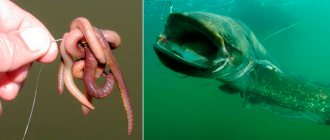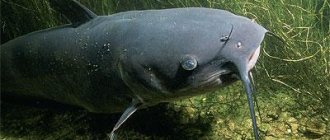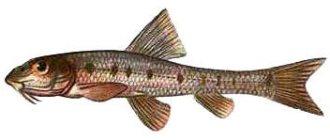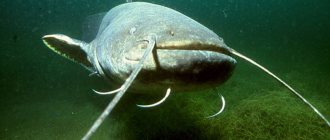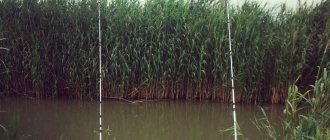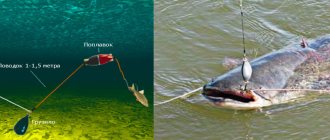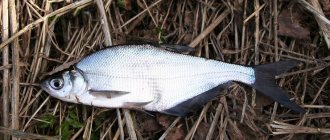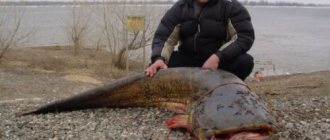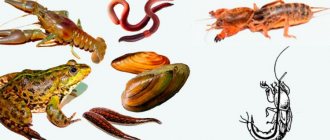Fishing on Akhtuba in September: tips, photos and videos
The first autumn month, September, opens the “golden season” of fishing on Akhtuba in Three Rivers.
The midday sun is still baking in the blue bottomless sky, but at night it is already becoming noticeably cooler. Nature has frozen at the turn of the seasons... Over the Astrakhan steppes, the days are still clear and warm, the summer haze covering the distant horizon has dissipated, and the nights are getting longer and now, just before dawn, the first frost appears on the burnt-out feather grass stems. Bird chirping has become wary, cicadas and grasshoppers are falling silent. And the life of underwater inhabitants is still in full swing. The streams in the riverbeds become more transparent. In the water that slowly cools at night, among the reeds, large carp are fiddling around, trying to eat before the cold snaps. Asp, losing caution, increasingly organizes a “fight” in the dawn twilight, forming the famous asp cauldrons. Bursts of powerful tails follow continuously. After the August pause, the mustachioed giant of the Lower Volga, the river catfish, again began hunting for gaping crayfish and whitefish.
The pike perch became active on the deep channel edges. The grass pike leaves the thickets in shallow waters and goes into a deep snag. The autumn fishing season begins, which will bring a worthy trophy to the patient fisherman.
In Astrakhan, September is practically a summer month and you can get by with ordinary summer gear. The fish are still taking well both in shallow and deep waters. It is excellent to catch pike perch, asp and large pike on the track (trolling). The float of a fishing rod somewhere in a quiet backwater goes under the water, barely touching the surface.
The life of underwater inhabitants changes noticeably only at the end of the month, when the water noticeably cools down. Cyprinids, primarily asp, rudd, roach, followed by chub and ide, gather in schools and move from the coastal zone to deeper places, closer to wintering holes. They are soon followed by ruff, perch and bersh. The catfish stops making night forays into the shallows from their favorite pools for the winter.
At the same time, in many species of fish, including predators, as the water cools, the autumn hunger intensifies. They are trying to accumulate more fat for a successful winter.
So by the end of September on Akhtuba, the main fishing seems to move from the banks and backwaters to open deep sections of channels and channels, to the pits. You can't do without a boat here. Pike still take well on artificial baits with slow retrieves, but increasingly prefer more “static” live bait on a bottom or float rod.
The asp is still active, but is caught from greater depths and is periodically caught on a jig, slowly drawn almost along the bottom near a channel hole or trench. But the perch is going crazy. Not wanting to miss a single crumb of food, September perch attacks almost everything that moves, regardless of the size of the prey. At this time, perch fishing can be especially exciting, you just have to find a hunting spot for a school of perch. Small spinners, castmasters, microjigs with silicone bait and just a float rod with a worm - any tackle will be catchy at this moment.
As October approaches, large bream are practically no longer caught, followed by ide. Roach, silver bream and dace, on the contrary, are excellently caught on a donk and a float until severe frosts. You just need to take into account that with the onset of autumn, you should catch peaceful fish on Akhtuba using animal baits: worm, bloodworm, shell. In inclement weather, burbot can bite well.
In mid-September there are usually fine days of “Indian summer” and therefore fishing at this time is not only catchy for almost all types of fish, but extremely pleasant and comfortable. And fish caught in the fall has a special taste; its meat becomes fatty and juicy. And to top off all the pleasures, an abundance of fruits and melons appears in these parts - the famous Astrakhan watermelons and melons.
When and where to catch catfish in spring
Traditionally, spring is the best time for fishing, both for catfish and any other fish, because the aquatic world is just waking up from winter icing and the water rapids are diverging. And some types of fish begin seasonal migration and spawning. I worry the least about other fish now, all eyes are on the ruler of the reservoirs, the catfish. The best time for fishing is considered to be in the morning, when the sun is just rising, it all depends on the month, but it is recommended to start at 4-5 o’clock.
For those who do not like early rises, it is possible to go in the afternoon, when the sun warms up the water well. The best time is considered to be when it begins to get dark, because catfish are hunters, and they begin to hunt most actively closer to night. If in the morning you should look for catfish in river holes, then in the evening he tries to stay closer to the shore in order to catch his prey.
The usual habitat for catfish is considered to be deep and dark holes, but if there are a lot of them in the river, then it obviously won’t be found in every one. In such a situation, you can try to find it in each, but if we are talking about large rivers, then a season may pass until all the holes are tested.
You shouldn’t rely on blind luck in this matter, so here are a number of tips to quickly and efficiently determine the habitat of catfish:
- You need to look for the deepest and darkest places.
- Catfish love hard and clay bottoms.
- Catfish will give preference to a house with “interior decoration”, so you are looking for old wood, fragments of trees, and so on.
- Catfish are very rarely located in areas with abundant vegetation, so this is excluded.
These tips are by no means universal for all bodies of water, but they will help save time on searching, so it’s worth listening to them. If you find a suitable place, but there are no catfish there, then there is no need to despair, you should try at another time of the day (if you caught it in the morning, then come in the evening). The fact is that catfish can change several places in a day, which is why they are considered so elusive.
Video on catching catfish on a donk in the spring:
Behavior in early spring (March, April)
Early spring is a good time to open the fishing season and, at the same time, hunt for catfish. But this period (from March to early April) has a number of disadvantages. The most important thing is that when the water warms up, catfish begin their active hunting, which means that wintering aggregations break up into small groups. With such compositions, they begin to plow the reservoir in search of food, which makes them more difficult to detect. The second disadvantage is not strongly related to fish, but concerns the situation on the surface of the water. Melting ice, and in some regions very slowly, interferes with fishing, which is why most fishermen prefer to wait until the second half of April to thoroughly begin catching catfish that have already calmed down.
Catfish behavior in May
In winter, catfish fall into deep hibernation, and with the first rays of the spring sun they begin to wake up. The awakening is by no means gradual; as soon as the ice crust melts off and the water begins to warm up normally, the activity of the catfish increases sharply. Their large groups break up, and everyone looks for their own prey, but by the end of April their activity decreases, and the regime begins to take on a measured pace. And just in May, the ideal time comes to spend your time catching catfish, and not searching for its habitat.
In May, catfish behave relatively calmly, especially in the morning and in the first half of the day, when the water is just warming up. At this time, you need to look for it in holes, snags, and so on. But closer to night, when the water warms up well, the catfish becomes more active
You should no longer look in the usual pits, but pay attention to the habitats of the small fish on which it feeds. Of course, it becomes more difficult to find the place, but thanks to the increased activity, the chance of a bite also increases.
Behavior of river inhabitants in early autumn
The arrival of calendar autumn does not mean that it will be cold, it will rain, and so on. During the first half of September, Mother Nature will still delight you with warm days. It is quite possible that the hot summer weather will last for a couple of weeks. However, fishing on Akhtuba will take on an autumn character. Dense aquatic vegetation, which has been rampant throughout the summer, will settle in the creeks and backwaters. Thanks to this, new promising places will open up that were previously inaccessible. Having lost herbal protection, the fish becomes more active. In addition, in preparation for a long winter, it will begin to feed intensively and delight fishermen with confident bites.
Predators will become especially voracious. Due to the withering of vegetation, the oxygen level in the water will significantly decrease, and this in turn will force many underwater inhabitants to move to deeper areas with intense currents. The peaceful fish will be followed by the predatory fish. In places of such accumulations, you will be able to observe the famous Akhtuba cauldrons - real water battles, there is no other way to describe them. The asp is distinguished by the greatest aggressiveness, without a twinge of conscience exterminating the young fish generation.
Together with the asp, the catfish will move closer to the seething whirlpools and sandy river rifts. Anticipating the approaching cold, in September he grabs everything that fits in his huge mouth. Ilmen and lakes, of which there are countless numbers near Akhtuba, will delight anglers with productive fishing for pike and perch, and in the eriks between them you can effectively catch tench. Carp is also active in September. In September, decent specimens of this fish usually occupy deep snag holes under steep banks.
Catfish behavior in September and October
Catfish are heat-loving fish, which means that in the fall they begin to eat. The giant needs to thoroughly accumulate fat so that during hibernation the body can feed itself.
It is not difficult to guess that such a voluminous carcass will need a lot of food. And if in the summer the lazy catfish preferred to feed only in the dark, then with the onset of autumn it begins to hunt during the day.
However, despite its gluttony, catfish are very capricious and react sharply to temperature changes and weather changes. As a result, September is considered the best month for catching it. Still warm water has a beneficial effect on the activity of the predator. In October, the catfish bite decreases sharply. Especially in rainy weather.
Fishing on sunny days with kwok will be more productive. But only those fishermen who know the winter hibernation places of the mustachioed predator, setting up an ambush on the approaches to them. In November, you can count on catching catfish only in the southern regions of the country, where the weather is relatively warm until the very end of autumn.
Where to catch catfish
To catch a catfish, it is not enough to simply throw bait into a pond. In this case, you will have to wait a very long time for a bite, and in the end you will go home empty-handed. Catfish should be caught where it feeds:
- in September, you need to look for the mustachioed predator near the riverbed edges, in snags and pools, as well as in deep holes;
- from mid-autumn, catfish move to deep areas. On rivers, it can hide in coastal burrows, ambushing game passing by.
Angler experience is the basis for successfully finding a catfish feeding area.
Features of catching predatory fish
As mentioned in the previous section, predators become active in the first month of autumn. The leader in this category is the toothy pike. You can catch it with all types of spinning baits. Spoons, silicone, foam fish, and wobblers work equally well. Not far behind the toothy and striped robber is the perch, which often attacks baits almost the same size as itself. In September, there are a lot of perches not only in bays and lakes, they hunt throughout the river, not being tied to any specific conditions. Small and medium-sized specimens are caught closer to the shore, and at depth you can provoke a humpback whale weighing up to a kilogram to bite.
Spinning is not the only tool suitable for fishing for predators on Akhtuba in early autumn. Live bait gear competes well with it: bait stations, mugs, live bait fishing rods.
After the summer heat subsides, the owner of the river, the catfish, begins to actively feed. Kwok, which brought good catches during the three summer months, is irrelevant in September. During this period, donks and traditional baits such as a frog, small fish or a piece of meat smoked over a fire work much more effectively. In search of food, catfish constantly moves; you can catch it in a variety of areas: in deep holes and shallow water, in rapids and in quiet pools. In early autumn, he develops an insatiable appetite and becomes less picky about food.
But the Akhtuba pike perch, unlike catfish, does not leave its “familiar” summer places until mid-September, but also increases its activity. The fanged one takes well on spinners and jig baits if you move them slowly near the bottom. You can take it from a boat not only using a spinning rod, but also using the vertical trolling method.
The asp is literally furious. The blows of its powerful tail are heard in places with strong currents - on riffles and whirlpools. The favorite delicacy of this predator is bleaks and small roach, but for some reason it bites worse on live fry than on artificial baits.
Features of catching pike perch, asp and catfish
According to fishermen's observations, pike perch becomes active towards the end of September. But throughout the month, where there is a strong current, “asp boilers” increasingly appear, where asp attack young fish. You can also try your luck in catching asp on the rifts.
Catfish in the first two weeks of September are still well caught by trolling, especially on small reaches and riffles, and later, until the end of the month, they become more and more active near channel holes. When the season of winds and strong water fluctuations comes, catching catfish with sound baits loses its effectiveness. More effective during this period is fishing with jigs, bottom tackle, as well as trolling using a deep-sea wobbler.
Fishing on the Volga in September is good for its accessibility, since this river connects many Russian regions. You can simply choose the nearest recreation center located on the Volga and go there to take a break from the hustle and bustle, be alone with yourself and calmly fish while enjoying the colorful September landscapes. And you can find the most convenient and inexpensive Volga recreation centers on this website.
www.rf-fishing.ru
By the end of August, the banks of the Volga and Akhtuba are gradually emptying, tourists are heading back to their cities and towns.
In September there are almost no holidaymakers here. After all, vacations are ending, a new school year is starting, and the time for classes in schools and institutes begins. In addition, purely natural factors also operate: at night the coolness becomes unpleasant and spending the night in a tent is completely uncomfortable. But during the day the air can still warm up to 30 degrees, and sometimes higher. Gradually, as the water cools down, the water in the reservoirs stops blooming, the algae goes to the bottom and fishing becomes possible even in those places that were too overgrown in the summer. Predators such as pike, perch, and peaceful fish like tench become active at this time. Fishing in Astrakhan in September is more conducive to catching predators. Following the fish they hunt, they prefer to stay in schools where there is a fairly strong current, the water is colder and contains more oxygen. With the onset of September, asp begins to behave more actively, and then pike perch. So-called boilers are becoming a common occurrence. Their schools of asps are formed by driving young fish there, which are destined to become prey for predators. The asp feasts on the rifts and in the whirlpools that form above the pits. As in previous months, fishing in September can bring catfish as prey. You need to look for it at the beginning of the month on the rifts and on the stretches between them. The closer to the end of September, the more often catfish are found near channel holes. It is no longer possible to catch it with a mallet; after the wind has gained strength and began to disturb the water, this method does not bring the desired effect. Fishing on the Volga in September is the time to use a donka or a spinning jig to catch a mustachioed predator. You can also try trolling using a deep wobbler. In the first month of autumn, lakes and ilmens are teeming with perches and pikes. At this time, perch bites on artificial baits, but it definitely won’t ignore small bait fish. Pike can be caught from the shore or by trolling (depending on the situation) in lakes and channels. Fishing in Astrakhan in September can also be done to catch white fish, which also bite well at this moment. If you know how to handle bottom tackle, you can catch bream on reaches with a powerful current at a depth of up to 6 meters. In deep and narrow channels connecting large floodplain lakes, tench are good for catching worms and crayfish necks. It bites best at dawn, but the opportunity to hook this fish remains throughout the full daylight hours. where the specimens can go are quite worthy. Shallow reaches, as before, attract carp, which do not hesitate to show their activity there. It is worth noting that fishing in the Astrakhan region in September is exactly the case when the probability of getting a good carp out of the water increases significantly compared to other months. In September, the sun's rays become not strong enough to warm up the water column well, and the temperature in the river drops; carp leaves shallow areas and migrates to deep holes under cliffs, replete with snags. Fishing on the Volga in September is good because during the day fishermen are not bothered by the crazy heat observed in the summer months, while the fish bite is quite decent. For a change, you can sunbathe, collect the last portions of heat sent by the sun, which warms up more and more reluctantly every day. If, in addition to your passion for fishing, you also have a good understanding of edible mushrooms, your pastime on the banks of the Volga and Akhtuba can be very varied. Fishing in the Astrakhan region in September at the Fishing Hall base is the choice of people who know how to find the ideal compromise between service and price. The complex offers vacationers the rental of gear, refrigerators for keeping fish fresh and other necessary equipment, and the rental of modern motor boats. Comfortable conditions have been created at the base so that if you stay here for a long time, you will not experience problems with everyday life. The holiday houses have electricity and sewerage. The rooms have a shower and toilet, hot water, TV and air conditioning. We are waiting for you in September. Phone number for reservations and inquiries:
+7, Moscow, Astrakhan
fishinghall.ru
Features of catching peaceful species
In September, white fish on Akhtuba continues to adhere to the summer feeding regime. The feeder is great for catching bream, “plowing” the bottom at a depth of 3 meters. If you have a boat, you can get it with float tackle. The main thing is to choose the right place. As the temperature drops, he pays less and less attention to plant baits, so it is better to offer him a maggot or a worm. Bait is required, but at this time of year you should not overuse strong flavors.
The carp is no longer as careful as in the summer. It is at the beginning of autumn that the largest specimens of this fish are caught on Akhtuba. In the first days of the month, the carp still bites on peas, corn and other plant baits, but gradually its preferences change in favor of various living creatures. When it completely moves from shallow water to holes, it is more advisable to use worms and maggots as bait. It is not for nothing that carp is called wild carp. He is really wild and very strong, capable of breaking a fishing line with one powerful jerk. Therefore, reliable carp gear with all the positive qualities that they possess is more suitable for such fishing. The only drawback is the high cost; not every angler can afford such a tool.
Bream habitats on Akhtuba
In Akhtuba and its branches, bream prefers places with warm, quiet water, with a sandy and silty or clayey bottom and therefore most often it can be found in bays on the river, in flowing lakes and deep ilmen. As a rule, large bream lives at depth, but avoids areas with a flat sandy bottom and strong currents. Smaller specimens stay closer to the shore, choosing whirlpools, backwaters and bends with reverse streams for parking and feeding.
In the spring before spawning and at the beginning of summer, bream move in schools right near the shore. On Akhtuba, bream prefers places with a lot of aquatic vegetation near deep waters. The bream bite at depth is good in the morning and evening, but at noon the bream can also bite well - at this time it carefully approaches the coastal vegetation in search of food. By the way, ide and large rudd are “grazing” there at this time. In the warm season, bream can be caught well at night.
Fishing in September
In September, on the Akhtuba River and the Lower Volga, despite the calendar autumn, summer continues. Vacations are over and there are significantly fewer “wild” tourists on the river banks. The daytime heat subsides and there is almost no heat in the second half of September, although the weather in the Astrakhan region remains warm and dry - the “ velvet season ” begins. At the beginning of September, the water in the rivers is still warm enough and you can continue swimming and sunbathing; its level usually remains at a low level, but if there are heavy rains in the upper reaches of the Volga, then by the end of September the water level in Akhtuba can rise significantly. Good weather, an abundance of fruits, the absence of blood-sucking insects - all this accompanies an excellent holiday on Akhtuba in September.
September in the Lower Volga is the time when fish begin to prepare for winter, gain fat, eat heavily and thereby delight fishermen with a good bite. Fishing in September on Akhtuba continues all the best traditions of summer fishing. This applies to places and objects of fishing, gear, lures and baits, and methods of fishing. As the water gets colder towards the end of September, the fish begin to move to deeper places closer to the holes, and fishermen should also move there. The time is coming for catching predatory fish with a jig-spinning rod, so September and autumn in general are the best time for fishermen specializing in catching predators.
Selecting a location
Carp and carp inhabit many different bodies of water: from small ponds, lakes and small rivers to huge reservoirs. Therefore, fishing for carp is available to most anglers, although, of course, fishing on the Volga, Don and other large rivers will be the best in terms of the size of the trophy.
For many anglers, the most desirable thing is to catch carp in Astrakhan, a place with a special nature, thanks to the delta of the great Russian river with its numerous tributaries, channels and eriks. If you don’t have the opportunity to be on the Volga in September, don’t despair, you can do some good fishing on an ordinary pond.
As for the local location of fish in a reservoir, carp, like most bottom-dwelling fish, chooses places with pronounced anomalies. These can be both striking changes in the bottom relief and natural and man-made objects brought under water.
This applies equally to fishing in September on a pond, and to fishing for carp on the lower Volga or in another large body of water. Therefore, when choosing a point for casting equipment, take into account the following locations:
- coastal and riverine dumps;
- entrance and exit from the pit;
- places with reverse flow;
- parallel spits protruding into the reservoir;
- snags, flooded trees;
- stones;
- large construction waste;
- elements of hydraulic structures.
How and what to catch bream on Akhtuba
In Trekhrechye, bream can be caught throughout the year. The bream is very cautious and timid, afraid of any noise and especially knocking, it can even be alarmed
fisherman's shadow on the water.
Bloodworms, maggots, worms, corn and other plant baits are suitable as bait for catching bream on Akhtuba. It is best to make a “sandwich” from plant and animal bait.
About methods of catching bream. Fishing on Akhtuba for bream occurs using bottom gear (optimally) - a feeder or “elastic band” or a float rod (with blind or sliding equipment). For night fishing from the shore, the most convenient way is to fish with bottom tackle with a rubber shock absorber (elastic band).
An excellent catch of bream awaits the fisherman when fishing from a boat at depth using bottom tackle. In all cases, the bait should be placed on the bottom or slightly raised from it. The place where you catch bream must be carefully fed (when fishing at night, this is done immediately after dark, otherwise the bait will be carried away by small fish), then the chances of catching a large specimen of bream will increase significantly. For such fishing, you can effectively use feeder tackle or tackle with a sliding float for long-distance casting (for night fishing, you can use special beacons with chemical light that are attached to the float).
Bream bite well on Akhtuba in winter, especially on the first and last ice. Places for fishing bream in winter should be deep, with an uneven bottom and weak current. Bream are caught from the ice using a float or jig tackle baited with bloodworms or burdock moth larvae.
